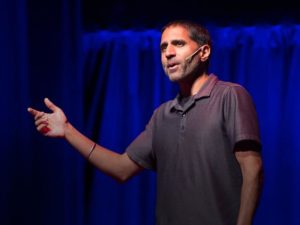Introduction
There is a need for more critical scholarly engagement between critical disability studies (CDS) and rehabilitation sciences (RS). CDS and RS arguably occupy opposite ends of a continuum—ranging from a critical stance toward the production of disability, to a medically-derived perspective of disability as a problem requiring intervention. This article calls for an approach to inquiry that unsettles knowledge relations that position CDS and RS as oppositional and incompatible. As an alternative to these dominant understandings, CDS with RS uses the tension between both perspectives as a unique opportunity to negotiate and prioritize what really matters when working with and for disabled people.
In order to demonstrate the value of this critical engagement, I will begin by first exploring my experience as a doctoral student in rehabilitation sciences. Next, I will outline the central tenets of what I call CDS with RS. I will then draw on post-structuralism and CDS to critique the World Health Organization’s (WHO) International Classification of Functioning, Disability and Health (ICF) as a means to highlight the merits of CDS with RS as a mode of research and practice. Finally, I will conclude by discussing how CDS with RS allows for enhanced scholarship that questions the taken-for-granted values, meanings, and qualities attributed to the category of the human, and provides suggestions to creatively re-think rehabilitation theory and practice.
The Educational Experience
I write this 10 months into my PhD studies in rehabilitation sciences. While I am still in the process of immersing myself in literature, this paper provides me with a preliminary opportunity to explore some of the philosophical tensions in my work. My research draws on sociology, critical disability studies, post-structural and new materialist theories, and disabled children’s childhood studies to critically interrogate the production of childhood disability in children’s rehabilitation. My work aims to highlight how social, cultural, and institutional mechanisms produce and regulate notions of ab/normality and disabled identities, which can unintentionally construct disabled youth in harmful ways. Fueled by both frustration and passion, this article is my first attempt at setting the stage for critical and transdisciplinary rehabilitation scholarship.
Unlike many other students in my cohort, I cannot say that I chose to pursue my doctoral studies because I had a particular project in mind. As a sociology student, I knew that I thrived when engaging in theoretically-diverse scholarship committed to unveiling hidden assumptions about humans and bodies in contemporary Western societies. Consequently, I knew my doctoral project had to question the ontological certainty of the neoliberal human—or, in other words, the meanings and assumptions regarding the ‘nature’ of what it is to be human. I fortunately found a brilliant scholar, Barbara Gibson, whose work did exactly that.1,2 Gibson’s writing was eloquent, and her ideas sharp. Reading her work inspired me to unearth and challenge the normative and ableist assumptions that predicate rehabilitation practice, research, and education. Charged with this energy, I began my doctoral studies knowing I was committed to bringing a CDS perspective to the field of rehabilitation in order to enhance therapy and practice. But the question remained, how to do it?
My first class as a PhD student was an introduction to rehabilitation models and theories. As a sociology major, the theory excited me; I was eager to learn new ways of thinking about the human body. To my disappointment, the course did not engage with critical thinking or interdisciplinary scholarship, and instead, consisted of reciting biomedical models and mid-range theories. Consequently, the course did not offer any opportunity to discuss or explore the implicit values and underlying assumptions of this work. While this experience was frustrating, it was also a blessing in disguise. Not only did the course fuel my desire to craft a critical and creative research agenda, it also introduced me to a plethora of normative assumptions, readily waiting to be unpacked, critiqued, and re-imagined. Furthermore, the course opened my eyes to the myriad ways in which enhanced methodological engagement between critical social theory and rehabilitation had the potential to improve rehabilitation theory and practice.
Engaging Polarizing Perspectives
The disciplines of CDS and RS are somewhat fragmented.3,4 Disability studies scholars and activists have described their experiences in rehabilitation as being oppressive due to the way in which therapies focus on normalizing disabled bodies.5,6 Furthermore, scholars within the field of rehabilitation have highlighted the dominance of positivism and scientific-based methods that often ignore the lived experiences of disabled people.7-10 In turn, many—from both CDS and RS—feel as if rehabilitation therapies are done to patients rather than with or for patients.4,11 As a result, scholarly engagement between CDS and RS has been reduced to a useful, yet arguably repetitive critique of rehabilitation’s underlying theoretical assumptions regarding the ‘nature’ of the human body.4,12
This lack of interdisciplinary theoretical engagement is unfortunate, and directly impacts the types of knowledge produced. Although these two seemingly disparate fields of knowledge seem irreconcilable, might there be a way to harness this tension and turn it into something more fruitful? What productive opportunities might emerge from a more sincere engagement of these two polarizing perspectives? Speaking more generally of the relationship between critical social science and public health, Mykhalovskiy et al13 argue:
Critical social science with [emphasis added] public health means a set of research practices that orients to epistemological and political differences between social science and public health as productive opportunities… Critical social science with [emphasis added] public health unsettles knowledge relations that position social science as a conceptual resource for public health or as a source of negative critique of public health activities13(p4)
Mykhalovskiy et al’s assertion highlights the potential for a meaningful relationship to be formed between CDS and RS. To further demonstrate this point, in this article I argue that it is vital that the philosophical and political differences between CDS and rehabilitation are re-imagined as positive opportunities for engagement. While CDS is not just a conceptual lens through which to critique rehabilitation, rehabilitation is not just a medical practice oriented to the normalization of impaired bodies. Thus, as a “mode of scholarly engagement,”13(p2) CDS with RS allows for a deeper analysis of the plethora of ideas, assumptions, and discourses that support the ontology, or the ‘nature’ of the ideal and ‘normal’ abled body. While such an approach aims to lessen the (unintended) harmful effects of traditional (medically-based) rehabilitation practices, it also contributes to the development of a critical and transdisciplinary rehabilitation scholarship.
ICF: Background and Development
To ground these insights and provide context, it is necessary to briefly explore the history and theoretical development of the World Health Organization’s (WHO) International Classification of Functioning, Disability and Health (ICF). Although there are many different ways to theorize disability and impairment, it is widely agreed that biomedical discourses (the medical model) and social theories of disablement (social models) are polarities that occupy opposite ends of a range of perspectives. At one end, biomedical discourses originate from the medical professions (hence the name medical model) and contend that impairments are a consequence of biological dysfunction that causes disability. This medicalized view of impairment reduces disability to a malfunctioning body part and renders disability as an individual, biological problem to be fixed.
By contrast, social models of disability contend that although physical impairments are ‘real’, disability is socio-culturally produced by exclusionary practices and unequal access to resources. Proponents of these perspectives have attempted to expand the medicalized view of disability to consider the multiple ways in which environmental and attitudinal barriers create fundamentally restrictive conditions that prohibit the full participation of disabled people. It is important to note, however, that social theories of disablement were never intended to replace the medical model.11 Instead, they were conceptualized as mechanisms to be used in tandem with the medical model when necessary. The underlying reason for the inception of the social model was to address the socio-political limitations inherent within a solely individual pathological approach to disability.
Thomas14(p37) notes that many presentations of the social model are also reductionist oversimplifications of its tenets. In particular, she argues that social theories of disablement do tend toward the material aspects of impairment by highlighting how these approaches position disability as social exclusion based on impairment. Thus, she argues, social models defend the idea that impairments do not cause disability, but rather are the basis upon which disability as social exclusion operates.
While the medical model projects disability as an individual pathology, social models of disablement posit disability as a form of social oppression.15,16 Importantly, and despite their differences, both approaches have been criticized for failing to acknowledge the multifaceted ‘nature’ of disability and impairment. Those opposed to the medical model have highlighted how it places shame and blame on individuals and fails to hold society accountable for its unjust policies and practices.15,16 Conversely, those who are critical of social models argue that they dismiss the lived experiences of disability and fail to theorize the interrelation between disability and impairments.17,18 What is important to note here is that both accounts have been critiqued for failing to adequately theorize the relation between disability and impairments.
An Attempt at Synthesis
In an effort to address these limitations, the WHO’s (2001) ICF attempts to synthesize both approaches to emphasize a dialectic relation between biomedical and socio-political determinants of health. The WHO describes the ICF as a unifying framework of concepts and terminology “for describing and organizing information on functioning and disability [that] provides a standard language and conceptual basis for the definition and measurement of health and disability.”19(p1) Composed of a model (conceptual basis) as well as an extensive set of codes (standard language), the ICF is a multipurpose classification system designed to be used in various disciplines and sectors.20,21 Instead of reducing disability to either physiological (medical model) or social causes (social model), the ICF claims to adopt a biopsychosocial model of disability, which emphasizes a more relational understanding of the multiple mediators of disablement. This integrated approach attempts to shift focus from cause to impact—from traditional classifications of disability and health to a broader focus on the level of health.20 Thus—as the WHO contends—the ICF acknowledges the complexity between disabilities and environments.
The WHO’s first model of disablement was the 1980 International Classification of Impairments, Disabilities and Handicaps (ICIDH).22 The ICIDH was critiqued for the ways in which it adopted the medical model’s “bioreductionist” view of impairment. A bioreductionist perspective conceptualizes a diseased or impaired body as a biological abnormality. Importantly, bioreductionism views ‘abnormalities’ as isolated from the larger social and cultural context.23 Critics have highlighted how the ICIDH model, in adopting this overly-simplistic understanding of impairments and disability, inadvertently relies on a pre-existing notion of what counts as a biologically “normal” body.24-26 In an attempt to address this problem, the creators of the ICF removed the causal relation between impairment and disability by emphasizing how “health and health-related states” universally apply to everyone, and not just disabled people. In doing so, the model contends that the presence of impairment is not an immediate indicator of disability. Furthermore, the model also acknowledges the role of socio-political factors in an effort to remove the causal relationship between disability and impairment. (For example, an individual with HIV who may not exhibit any impairments could still be disabled due to their inability to access proper healthcare and/or resources.20)
The ICF and Rehabilitation
Within the field of rehabilitation, the introduction of the ICF has helped to accelerate changes to rehabilitation philosophy, practice, education, and research.2,27 For example, some have used the ICF as a framework for clinical decision-making in pediatric physical therapy;27 others have applied the framework and codes to the field of brain injury, drawing attention to the value of its “high trans-cultural validity.”28(p239) A systematic review of ICF usage from 2001 to 2009 indicates that it has contributed to the development of research on function and disability in clinical, rehabilitation, disability eligibility, and employment contexts.29 The review found that use of the ICF is expansive, covering a variety of fields and scientific journals, suggesting that “cultural change and new conceptualization of functioning and disability is happening.”29(p281) These examples demonstrate the ICF’s value to rehabilitation research in providing a common language for clinicians, practitioners, and researchers to classify, diagnose, and treat a variety of modes of disablement. This universal language allows researchers to access information from a variety of different contexts, thus enhancing the ability to analyze and interpret information in order to advance rehabilitation knowledge and practice.
However, the language of the ICF draws on discourses and logics that construct disability as inherently negative. Rehabilitation therapies that draw on the reductive logics of the ICF, therefore, are limited in their ability to help disabled people. This lack calls for a new interdisciplinary focus devoted to disrupting taken-for-granted assumptions regarding the ‘nature’ of the human, as a means to re-imagine what people can do and become.30
A CDS Critique of the ICF
Despite its wide interdisciplinary application, little work has critically examined the implications of the ICF for disabled people. Some exceptions are the work of Imrie,24 Gibson,1,2 and Hammel.3 Speaking directly to these gaps in knowledge, Imrie’s work highlights the theoretical and conceptual underdevelopment of the ICF, which, he argues, holds potential to reaffirm a reductive understanding of disability and impairment.24 Similarly, Gibson draws on Imrie to argue that the ICF’s use of statistical norms to define dysfunction, coupled with its reductive understanding of impairment, reinforces the taken-for-granted assumption that impairment is objectively problematic.1 The work of Hammel adds to this scholarship by highlighting how the model pays insufficient attention to the broader social, political, legal, or economic impacts on the production of wide-spread impairments.3 In what follows, I will draw on and extend this scholarship by highlighting how the ICF perpetuates notions of normal/abnormal, thus reinforcing the pervasive belief that disabled bodies are inherently problematic and in need of intervention.
The Conceptual Model of the ICF
From a CDS perspective, the lack of attention paid to the theoretical underpinnings of the ICF potentially poses serious problems for disabled people. CDS is an interdisciplinary theoretical lens that aims to explore the lived experiences of disabled people while also interrogating the production of ability, disability, and difference more widely.12,31,32 In order to provide for a deeper discussion, the remainder of this article will focus exclusively on the conceptual model of the ICF. I do this intentionally as a way to highlight the production and maintenance of ableism. As a central concept within CDS scholarship, ableism refers to a:
…network of beliefs, processes and practices that produces a particular kind of self and body (the corporeal standard) that is projected as perfect, species-typical and therefore essential and fully human. Disability then is cast as a diminished state of being human.32(p44)
Thus, in focusing on the underlying logics of the ICF, my aim is to shift the gaze away from disability to a more subtle exploration of the theoretical and philosophical assumptions that maintain and perpetuate ableist thinking.
Adhering to a biopsychosocial approach, the ICF model contends that disability is multidimensional and interactive, meaning that all components of disability are important and interconnected with one another. Thus, disability and functioning are seen as outcomes of interactions between “health conditions” and “contextual factors,” which include both “environmental” and “personal” factors.20 However, in an attempt to avoid the essentialism of both the medical and social models, the ICF employs a “value-neutral” perspective of impairment as objectively defective.24 Thus, from the perspective of the ICF, impairments are biologically rooted “problems in body function or structure such as significant deviation or loss.”20(p10)
While seemingly harmless, such an account of impairment is descriptive, pathological, and scientific, and inadvertently produces, operates, and maintains normal/abnormal, natural/unnatural, and abled/disabled binaries. These dualisms are problematic because they privilege one aspect or idea over another, and therefore fail to see the value or importance of the supposed lesser binary. Thus, in describing impairment as biologically inferior, the model indirectly relies on an understanding of what counts as a biologically superior body. Consequently, such dichotomous thinking privileges certain ontologies, or ways of being, over others. If the biologically ‘able’ body is projected as the ideal, anything that deviates from such bodily perfection is cast as abnormal, undesirable, and in need of fixing.33
Speaking directly to this problem, Imrie24 notes how these biomedical views of disability emerge from a:
…materialist ontology whereby the body is conceived as a distinct entity with specific anatomical and genetic characteristics which exist independently of scientific discourses about it… [Consequently] the materialist ontology of the ICF conceives of the human body (and impairment) as a physical entity that delimits and defines, in part, the boundaries and capacities of human action.24(p294-295)
Imrie’s insights render visible how the ICF constructs impairment as a form of embodiment that exists independently of the world around it. For the ICF, the able (biological) body is a given, or something that is already there. Such a position suggests that all bodies are pre-social entities that can be separated from the way in which we have come to understand and experience them. Importantly, this enacts a particular understanding of impairment as a pre-formed problematic way of being. In drawing on this logic, the ICF reduces human corporeality to static conceptions of the individual (eg, able/disabled) in ways that limit what humans can do and become.
Impairment as Inferiority
In relying on the notion of a biological (able) body, the ICF falsely constructs impairments as inherently and naturally inferior. From a CDS perspective, it is crucial to highlight how such a position suggests that impaired bodies fail to function at the normative and desired level of the typical corporeal body. Additionally, this indirectly blames impairments themselves as the primary source of harm experienced by the people who have them. In turn, disability is rendered as a negative way of being that requires intervention. Thus, the ICF’s conceptualization of impairment as a pre-social biological fact draws on ableist ideology and sets up a binary dynamic that is not only comparative but also co-relationally constitutive in that it reinforces exclusionary categories and ontologies (eg, ways of being human).2,32,33 Although the categories of ability and disability are not wrong in and of themselves, the underlying belief that one is normal and the other is abnormal reinforces the idea that particular bodies and functions are more preferable than others. Thus, the notion of the biological (able) body begets the defective impaired body. One cannot exist without the other. Consequently, rehabilitation scholarship and therapies that draw on the ICF are limited in their ability to help disabled people, because the problem of impairment remains internal to the disabled body. This is extremely problematic, as such a perspective leaves unchallenged the societal positioning of disability as lack and the negative effects of ableist thinking.
What is further, the ICF draws on scientific discourses and statistics to define what counts as an abled (biological) body. Thus, as the ICF notes:
[I]mpairment is a loss or deviation from certain generally accepted population standards in the biomedical status of the body and its functions… Abnormality here is used strictly to refer to a significant variation from established statistical norms…and should be used only in this sense.20(p213)
In other words, the biological abled body is a statistically-generated norm and is used as a standard against which the impaired and defective body is constituted. Presumably, the “only in this sense” clause is an attempt to remove the value-judgment from such deviation and instead suggest that abnormality “is a statistical variation presented as an unassailable objective fact.”2(p34) In drawing on this logic, the ICF reproduces the consistent view of disability as a negative form of “human morphology”33(p4) and thus constructs disability as ultimately undesirable.
A Post-Structural Perspective on the ICF
From a post-structural perspective, this reductive focus of the ICF (and related rehabilitation research and practice) on impairment as a pre-formed biological materiality fails to acknowledge the multiple ways in which bodies are inscribed with socio-cultural meanings and “materialized through discourse.”34(p176) In an attempt to subvert grand narratives (such as biomedical discourses) and totalizing truths (such as the objective existence of an able body), a poststructuralist stance suggests that the biological body can never be comprehended directly because knowledge and understanding are always mediated by dominant ways of thinking and speaking about the body, and particular onto-epistemologies, or ways of knowing.2,35 Thus, through a post-structural lens, the notion of the biological body is only ‘real’ in the sense that it is constituted in discourse. Likewise, the ‘abnormal’ body is only ‘real’ in the sense that it is produced by discourse. Accordingly, impairment is not, as the ICF and rehabilitation contend, some “natural” (and deviant) state, but rather, it constitutes a mode of living that changes character over time due to the way it is shaped and re-shaped by discourses and particular ways of knowing.2 In turn, “the body as we know it, is a fabrication, organized not according to an historically progressive discovery of the real, but as an always insecure and inconsistent artefact, which merely mimics material fixity.”36(p13)
To be clear, while bodies do materially ‘exist’, it is important to acknowledge how our understandings and experiences of such materiality are structured by discourse. From this perspective:
…we cannot understand bodies, or any other phenomena except through language—that is, through talking, writing and thinking with words and their meanings. Thus meanings and descriptions about what “the body” or a given body is or is not, are always imposed through discourse.2(p39)
In failing to address how discourses mediate our understanding and experience, the ICF projects impairments as pre-social abnormalities that characterize disabled bodies as problematic. Consequently, this logic reaffirms dualistic categories of difference (normal/abnormal) and systems of classification (abled/disabled) as objectively ‘real’. In turn, the approach advanced by the ICF only further stigmatizes and oppresses disabled people by disavowing a positive disabled sensibility. Thus, Campbell notes that despite the ICF’s intent, “[t]he reality of the outcome is that it does nothing to interrogate and challenge hegemonic ideas that exclude, separate and subordinate people with disabilities. Instead, the approach [of the ICF] actively promotes separation.”32(p23)
Although the ICF acknowledges a relationship between impairment and the socio-material environment (as in the previously-mentioned example of HIV and inaccessibility of resources), it maintains and perpetuates certain problems. As I have demonstrated, the ICF relies on a biomedical notion of impairment as objectively defective, while also drawing on statistical norms to understand what counts as a problem to be addressed. In doing so, the model reproduces the discourse of normal/abnormal and maintains that abnormality is deviant and in need of intervention. Consequently, the ICF re-inscribes the dichotomy of abled/disabled in a way that privileges abled bodies, and de-values disabled bodies.
Importantly, the ICF’s acknowledgment of the social mediators of disability does not preclude its reliance on the discourse of normal/abnormal. Indeed, my analysis has rendered visible the multiple ways in which an understanding of dysfunction predicated by statistical norms, and a bioreductionist understanding of impairment perpetuate an understanding of impairment as objectively defective prior to its measurement. These ideas are pervasive and extend beyond the ICF and rehabilitation, and influence how disability is understood in social contexts. The normal/abnormal, abled/disabled dichotomy is a prevalent social ‘truth’ which has a long history and holds severe implications for the way in which disabled people are understood.10 In order to question this social ‘truth’ critical attention must be paid to the theoretical and philosophical assumptions that predicate our understanding of the ‘nature’ of the human being.
Conclusion: CDS With RS and The ‘Nature’ of the Human
While it is important to alleviate suffering and discomfort, it is problematic to assume that ‘abnormal’ bodily differences such as impairments, are their sole mediators. Furthermore, the ICF’s positioning of impairment as a pre-social and biological deviance not only undermines its commitment to view disability through socio-political terms, but its widespread adoption in rehabilitation sciences also plays a direct role in perpetuating a culture of ableism in both rehabilitation and society more widely. Thus, a failure to engage with the philosophical foundations of the ICF paradoxically undermines rehabilitation science’s efforts to enhance the lives of disabled people by promoting a simplistic view of disability as inherently problematic. From a CDS perspective, ‘we’—scholars, clinicians, therapists, advocates, friends, and family members—are ethically responsible to consider the ways in which our understandings impact the lives of those we wish to help.
The arguments presented in this article render visible productive opportunities to re-configure rehabilitation research and practice. For example, I have argued that scientific discourses and statistics construct a particular ontological understanding of “human corporeality”37 that both maintains and perpetuates notions of normal/abnormal and consequently, disability. Given these insights, rehabilitation research and therapies may be more fruitful if they were to recognize difference as the default human condition. Such an approach would subvert the normative gaze of ableism and accept the inherent beauty of the diversity that characterizes the human body and life itself. This interdisciplinary and collaborative agenda requires us to question the meanings we have attributed to impairments, and the ways in which our understandings restrict what people can do and become.
As a mode of inquiry and practice, CDS with RS begins with the question of the ‘nature’ of the human being. In doing so, CDS with RS recognizes and addresses sources of tension between the two fields as a means to negotiate understandings regarding what it means to live a ‘good’ life. Integral to this endeavor is the way in which this scholarship accepts the tensions among critique, rehabilitation, and disability politics. CDS with RS is not an approach that guarantees ‘successful’ scholarship. That is, CDS with RS is not a mode of inquiry that seeks to resolve all tensions between these fields. Rather, its main concern lies in its ability to promote creative dialogue regarding the complex and adverse subjects of the human body and what it means to live a ‘good’ life.
As a kind of provocation, this article serves to exemplify the need for CDS with RS. The longstanding separation and skepticism that has characterized the relationship between CDS and RS has not only impacted the types of knowledges produced, but also, the particular practices central to rehabilitation. I have demonstrated the implications of this separation through an analysis of the ICF, which rendered visible the way in which the model and its widespread adoption in RS, perpetuates the discourse of normal/abnormal. What is further, my analysis tells a significant story about what kinds of bodies are valued in contemporary Western societies. Indeed, “such orderings are not just repressive, but they are ultimately productive; they tell us stories, they contain narratives as to ‘whom’ we are and how ‘we’ should be.”32(p10)
As a means to address these limitations, CDS with RS is an approach that invites and encourages us to explore the tensions between these two fields as productive opportunities for the enhancement of rehabilitation practice and scholarship, and the expansion of the ‘nature’ of the human. Importantly, there is no one singular expression of CDS with RS; rather, the emphasis is to move away from the common-sense approach of searching for complimentary interests to a more nuanced perception of the productive capacities of political and philosophical tensions.
Thus, CDS with RS is a mode of inquiry that accepts philosophical and theoretical tensions as a source of productive opportunity that allows for the mobilization of social theory and methodology to contribute to the enhancement of rehabilitation research and practice. As an attempt to draw attention to the taken-for-granted assumptions that predicate rehabilitation theory and practice, the version of CDS with RS that I have taken up in this article equips us with the necessary tools to expand on what kinds of humanity we enact in rehabilitation.








 Member since 2019 | JM14274
Member since 2019 | JM14274


NO COMMENT